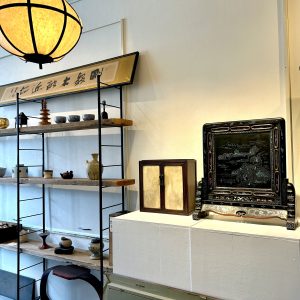万年筆は想像以上に精密に作られておりました(愛知県名古屋市千種区姫池通 骨董買取 古美術風光舎)
2025.01.16
誠に有難いことに、年末年始にかけ、ご自宅やご実家のお片付けをされている方からの査定や買取のご依頼が増えております。
ご自分で大切にされてきたお品、ご家族がコレクションされていたお品などには、それぞれ思いが込められていることを心に留め、丁寧に拝見させていただくよう努めております。

先日、買取に伺ったお宅の女性はとても素敵な万年筆を収集されていらっしゃいました。
お仕事で活躍されていた頃のお話などもお聞きすることができ、楽しい時間を過ごさせていただきました。大切にされてきた万年筆をはじめ、沢山の御品を分けていただき感謝申し上げます。
さて、私恥ずかしながら万年筆についてはほぼ知識がなく、モンブランは存じ上げておりますが、ウォーターマンと聞いて、万年筆はインクなのになぜウォーター?などと、とんでもなく的外れの疑問が頭を巡っておりました。
戻って調べてみますと、万年筆の基礎を開発した人物、アメリカのルイス・エドソン・ウォーターマンからきておりました。彼は1883年に世界で初めてインクを安定供給するために毛細管現象を応用した万年筆「レギュラー」を開発しました。
毛細管現象?ご存知の方もいらっしゃるでしょうが、簡単に説明しますと、水を張った容器に上から細い管を挿すと水が管の中に吸い上げられるという現象です。管が細いほど水は高く吸い上げられます。
よく昔の映画などで目にする羽根ペンも同じ原理で、羽根の軸は中が空洞になっておりインクを吸い上げ、その吸い上げたインクが紙と接することで文字が書ける仕組みです。この紙の繊維の間の空気にインクが移動する現象も毛細管現象なのだそうです。確かに吸い上げた後にぽたぽた落ちてこないのは何故?という疑問も湧いてきます。
調べれば調べるほど科学や物理の知識満載の複雑な仕組みとなっているのです。羽根ペンで優雅に文字をさらさらと書いてみたいなどと妄想しておりましたが、単にインクに浸して書くというシンプルなものではありませんでした。
しかし羽根ペンは吸ったインクを溜めておくスペースがなく、常にインク壺を携帯し、頻繁にインクに浸さなければなりませんでした。産業や教育の発展に伴い実用的なペンが求められるようになっていきます。
多くの開発者が様々な方法で挑戦し、ウオーターマンに行きついたようです。ウオーターマンの開発した万年筆の画期的なところは、一つの管で空気の通り道とインクの通り道を作り、スムーズにインクを補充できる仕組みを作ったことだそうです。詳しく説明してくれている動画を観たのですが、私の頭がついていけず上手くご説明はできませんのでご興味のある方はご覧になってみてください。興味深いということだけは補償いたします。
現在は通り道は二つに分けられ、インク漏れを防ぐ溝が作られるなど進化しています。
てっきり可愛い飾りだと思っていたペン先のハートの穴も、初めは空気の取り込み口としての役目があったようで、万年筆の内部もこんなにも精密機械のようになっているとは想像もしていませんでした。
ちなみにアジアでは、中国において約4500年前に、竹や木の棒に動物の毛をとりつけたものが使用された痕跡があり、秦の始皇帝の時代には獣毛を使った現代の筆の原型が生まれていたといわれています。筆も毛の間の細い空気の層に墨を吸い上げるという毛細管現象を利用しており、たっぷりと含まれた墨は羽根ペンに比べ多くの文字が書けました。改めて筆の凄さを感じます。
それにしましても、万年筆がこんなにも様々な色や形、インクの補充形態があるとは知りませんでした。
万年筆のペン先は、使っているうちに開いたり、摩耗したりするうちに持ち主の「書き癖」に合うように育っていき、濃淡や強弱により味のある文字を書くことができるといわれています。
かの夏目漱石は明治40年ころから万年筆を使い始め、デ・ラ・ルー社の「オノト」を愛用し、多くの名作を残したそうです。
影響されやすい性格ですので、自分に合う万年筆といつか運命の出会いをしてみたいと考え始めております。
それでは、また次の機会に。(スタッフH)
Thankfully, over the year-end and New Year holidays, we are receiving an increasing number of requests from people who are cleaning out their homes and family homes to evaluate and purchase items.
We try our best to carefully look at the items we purchase, keeping in mind that items that have been cherished by the owner or collected by family members are filled with their own feelings and emotions.
The other day, we visited a lady who had a very nice collection of fountain pens.
We had a great time talking with her about the time when she was active in her business. I would like to thank her for sharing her treasured fountain pens and many other items with us.
I am ashamed to admit that I have almost no knowledge of fountain pens, and although I know Montblanc, when I heard the name Waterman, I thought, “Why water? I was wondering why a fountain pen is made of ink and not of water.
I went back and looked it up, and found that the name was derived from the American Lewis Edson Waterman, the man who developed the basis of the fountain pen. In 1883, he developed the world’s first fountain pen “Regular” that applied capillary action to ensure a stable supply of ink.
Capillary action? Some of you may have heard of this phenomenon, but to explain it simply, when a thin tube is inserted into a container filled with water from above, the water is sucked up into the tube. The narrower the tube, the higher the water is sucked up.
The quill pen often seen in old movies is based on the same principle. The shaft of the quill pen is hollow and sucks up ink, which is then in contact with the paper to write letters. The phenomenon of ink moving into the air between the fibers of the paper is also said to be a capillary phenomenon. It is true that the question arises, “Why doesn’t the ink drip down after being sucked up? The more I look into it, the more I understand the science and physics behind it.
The more we investigate, the more complicated the mechanism becomes, full of knowledge of science and physics. I had fantasized about writing letters elegantly with a quill pen, but it was not as simple as simply dipping it into ink and writing.
However, quill pens did not have space to store the ink they sucked up, and one had to carry an inkwell with them at all times and dip them in ink frequently. As industry and education developed, so did the need for practical pens.
Many developers tried different methods and seemingly ended up with the Waterman. The revolutionary thing about the fountain pen developed by Waterman is that he created a mechanism that allows smooth ink refilling by creating an air passage and an ink passage in a single tube. I watched a video that explains it in detail, but my mind is not up to it and I can’t explain it well. I can only compensate for the fact that it is interesting.
The pathway is now divided into two, and a groove has been made to prevent ink leakage.
The heart-shaped hole in the nib, which I thought was just a cute decoration, seems to have served as an air intake port in the beginning.
In Asia, there are traces of the use of animal hair attached to bamboo or wooden sticks in China about 4,500 years ago, and it is said that the prototype of the modern brush using animal hair was born during the reign of the first emperor of the Qin Dynasty. The brush also utilized the capillary phenomenon of sucking up ink into the thin layer of air between the bristles, and the ink contained in abundance could be used to write more characters than a quill pen. Once again, I felt the greatness of the brush.
Even so, I had no idea that fountain pens come in so many different colors, shapes, and forms of ink refilling.
It is said that the nib of a fountain pen grows to match the owner’s “writing habits” as it opens and wears out during use, and that the shading and strength of the pen allows for the writing of letters with a certain flavor.
The famous Soseki Natsume began using fountain pens around 1907, and loved to use the “Onoto” pen made by De La Rue, which left behind many masterpieces.
Since I am easily influenced, I am beginning to think that one day I would like to have a fateful encounter with a fountain pen that suits me.
I will see you next time.
*****************
ご実家の整理やお片付けなどをされている方のご相談などが多くございます。
お片付けなどくれぐれもご無理のないようになさってくださいませ。
風光舎では古美術品や骨董品の他にも絵画や宝石、趣味のお品など様々なジャンルのものを買受しております。
お片付けをされていて、こういうものでもいいのかしらと迷われているものでも、どうぞお気軽にご相談下さいませ。
また風光舎は、出張買取も強化しております。ご近所はもちろん、愛知県内、岐阜県、三重県その他の県へも出張いたします。
まずは、お電話お待ちしております。
愛知県名古屋市千種区姫池通
骨董 買取【古美術 風光舎 名古屋店】
TEL052(734)8444
10:00-18:00 OPEN
#出張買取#骨董#古美術#骨董品#絵画#版画#茶道具#刀剣#彫刻

